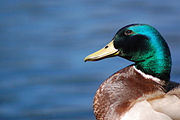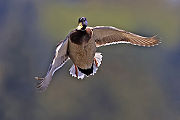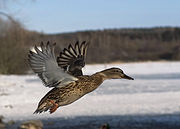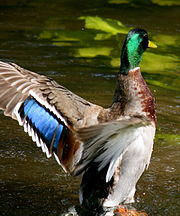
Mallard
Background to the schools Wikipedia
This wikipedia selection has been chosen by volunteers helping SOS Children from Wikipedia for this Wikipedia Selection for schools. A quick link for child sponsorship is http://www.sponsor-a-child.org.uk/
| Mallard | |
|---|---|
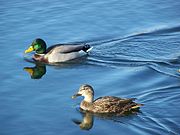 |
|
| Male (top) and female (bottom) | |
| Conservation status | |
|
Least Concern ( IUCN 3.1) |
|
| Scientific classification | |
| Kingdom: | Animalia |
| Phylum: | Chordata |
| Class: | Aves |
| Order: | Anseriformes |
| Family: | Anatidae |
| Subfamily: | Anatinae |
| Genus: | Anas |
| Species: | A. platyrhynchos |
| Binomial name | |
| Anas platyrhynchos Linnaeus, 1758 |
|
| Subspecies | |
|
See Mexican Duck, Anas and below |
|
| Synonyms | |
|
Anas boschas |
|
The Mallard (Anas platyrhynchos), probably the best-known and most recognizable of all ducks, is a dabbling duck which breeds throughout the temperate and sub-tropical areas of North America, Europe, Asia, New Zealand (where it is currently the most common duck species), and Australia. It is strongly migratory in the northern parts of its breeding range, and winters farther south. For example, in North America it winters south to Mexico, but also regularly strays into Central America and the Caribbean between September and May.
The Mallard and the Muscovy Duck are believed be the ancestors of all domestic ducks.
The Agreement on the Conservation of African-Eurasian Migratory Waterbirds ( AEWA) applies to the mallard.
Description
The mallard is 56–65 cm long, has a wingspan of 81–98 cm, and weighs 2-2 1/2 pounds. The breeding male is unmistakable, with a green head, black rear end and a yellow bill tipped with black (as opposed to the dark brown bill in females). The female Mallard is light brown, like most female dabbling ducks. However, both the female and male Mallards have distinct purple speculum edged with white, prominent in flight or at rest (though temporarily shedded during the annual summer molt). In non-breeding ( eclipse) plumage the drake becomes drab, looking more like the female, but still distinguishable by its yellow bill and reddish breast.
The Mallard is a rare example of both Allen's Rule and Bergmann's Rule in birds. Bergmann's Rule, which states that polar forms tend to be larger than related ones from warmer climates, has numerous examples in birds. Allen's Rule says that appendages like ears tend to be smaller in polar forms to minimize heat loss, and larger in tropical and desert equivalents to facilitate heat diffusion, and that the polar taxa are stockier overall. Examples of this rule in birds are rare, as they lack external ears. However, the bill of ducks is very well supplied with blood vessels and is vulnerable to cold.
The size of the Mallard varies clinally, and birds from Greenland, although larger than birds further south, have smaller bills and are stockier. It is sometimes separated as subspecies Greenland Mallard (A. p. conboschas).
In captivity, domestic ducks come in wild-type plumages, white, and other colours. Most of these colour variants are also known in domestic mallards not bred as livestock, but kept as pets, aviary birds, etc., where they are rare but increasing in availability.
A noisy species, the male has a nasal call, the female the " quack" always associated with ducks.
Ecology
The Mallard inhabits most wetlands, including parks, small ponds and rivers, and usually feeds by dabbling for plant food or grazing; there are reports of it eating frogs. It usually nests on a river bank, but not always near water. It is highly gregarious outside of the breeding season and will form large flocks, which are known as a sord.
Breeding behaviour
Mallards form pairs only until the female lays eggs, at which time she is left by the male. The clutch is 8–13 eggs, which are incubated for 27–28 days to hatching with 50–60 days to fledging. The ducklings are precocial, and can swim and feed themselves on insects as soon as they hatch, although they stay near the female for protection. Young ducklings are not naturally waterproof and rely on the mother to provide waterproofing. Mallards also have rates of male-male sexual activity that are unusually high for birds. In some cases, as many as 19% of pairs in a Mallard population are male-male homosexual.
When they pair off with mating partners, often one or several drakes will end up "left out". This group will sometimes target an isolated female duck — chasing, pestering and pecking at her until she weakens (a phenomenon referred to by researchers as rape flight), at which point each male will take turns copulating with the female. Male Mallards will also occasionally chase other males in the same way. (In one documented case, a male Mallard copulated with another male he was chasing after it had been killed when it flew into a glass window.)
Ancestor of almost all Domestic Ducks
Mallard (Anas platyrhynchos) is the ancestor of almost all of the varieties of domestic ducks. Domestic ducks belong to the subfamily Anatinae of the waterfowl family Anatidae. The wild mallard and Muscovy duck (Cairina moschata) are believed to be the ancestors of all domestic ducks.
Genetic pollution, hybridization and systematics

Release of feral Mallard Ducks worldwide is creating havoc on indigenous waterfowl, these don't migrate and stay back in the local breeding season and interbreed with indigenous rare wild ducks devastating local populations of closely related species through genetic pollution by producing fertile offspring. Complete hybridization of various species of rare wild duck gene pools could result in the extinction of many indigenous waterfowl. Wild Mallard itself is the ancestor of most domestic ducks and their naturally evolved wild gene pool gets genetically polluted in turn by the domesticated and feral populations.
Mallards frequently interbreed with their closest relatives in the genus Anas, such as the American Black Duck, and also with species more distantly related, for example the Northern Pintail, leading to various hybrids that may be fully fertile. This is quite unusual among different species, and apparently has its reasons in the fact that the Mallard evolved very rapidly and not too long ago, during the Late Pleistocene only. The distinct lineages of this radiation are usually kept separate due to non-overlapping ranges and behavioural cues, but are still not fully genetically incompatible. Mallards and their domesticated conspecifics are, of course, also fully interfertile.
The Mallard is considered an invasive species in New Zealand. There, and elsewhere, Mallards are spreading with increasing urbanization and hybridizing with local relatives. Over time, a continuum of hybrids ranging between almost typical examples of either species will develop; the speciation process beginning to reverse itself. This has created conservation concerns for relatives of the Mallard, such as the Hawaiian Duck, the A. s. superciliosa subspecies of the Pacific Black Duck, the American Black Duck, the Florida Duck, Meller's Duck, the Yellow-billed Duck, and the Mexican Duck, in the latter case even leading to a dispute whether these birds should be considered a species (and thus entitled to more conservation research and funding) or included in the mallard.
Like elsewhere worldwide the invasive alien mallard ducks are also causing severe “genetic pollution” of South Africa’s biodiversity by breeding with endemic ducks. The hybrids of mallard ducks and the Yellow-billed Duck are fertile and can produce more hybrid offspring. If this continues, only hybrids will occur and in the long term this will result in the extinction of various indigenous waterfowl worldwide like the yellow billed duck of South Africa. The mallard duck can cross breed with 45 other species and is posing a severe threat to the genetic integrity of indigenous waterfowls. Mallard ducks and their hybrids compete with indigenous birds for resources such as food, nest sites and roosting sites. The drakes (males) also kill the offspring of other waterfowl species by attacking and drowning them.
On the other hand, the Chinese Spotbill is currently introgressing into the mallard populations of the Primorsky Krai, possibly due to habitat changes from global warming. The Mariana Mallard was a resident allopatric population - in most respects a good species - apparently initially derived from Mallard × Pacific Black Duck hybrids; unfortunately, it became extinct in the 1980s. In addition, feral domestic ducks interbreeding with Mallards have led to a size increase - especially in drakes - in most Mallards in urban areas. Rape flights between normal-sized females and such stronger males are liable to end with the female being drowned by the males' combined weight.
It was generally assumed that as the spectacular nuptial plumage of Mallard drakes is obviously the result of sexual selection - most species in the mallard group being sexually monomorphic -, hybrid matings would preferentially take place between females of monomorphic relatives and Mallard drakes instead of the other way around. But this generalization was found to be incorrect.
Note that it is not the hybridization itself that causes most conservation concerns. The Laysan Duck is an insular relative of the mallard with a very small and fluctuating population. Mallards sometimes arrive on its island home during migration, and can be expected to occasionally have remained and hybridized with Laysan Ducks as long as these species exist. But these hybrids are less well adapted to the peculiar ecological conditions of Laysan Island than the local ducks, and thus have lower fitness, and furthermore, there were - apart from a brief time in the early 20th century when the Laysan Duck was almost extinct - always much more Laysan Ducks than stray Mallards. Thus, in this case, the hybrid lineages would rapidly fail.
In the cases mentioned above, however, ecological changes and hunting have led to a decline of local species; for example, the New Zealand Gray Duck's population declined drastically due to overhunting in the mid-20th century (Williams & Basse 2006). In the Hawaiian Duck, it seems that hybrid offspring are less well-adapted to native habitat and that utilizing them in reintroduction projects makes these less than successful. In conclusion, the crucial point underlying the problems of Mallards "hybridizing away" relatives is far less a consequence of Mallards spreading, but of local ducks declining; allopatric speciation and isolating behaviour have produced today's diversity of Mallard-like ducks despite the fact that in most if not all of these populations, hybridization must always have occurred to some extent. Given time and a population of sufficient size exists, natural selection ought to suppress harmful allele combinations to a negligible level.
The aforementioned confounds analysis of the evolution considerably. Analyses of good samples of mtDNA sequences give the confusing picture one expects from a wide-ranging species that has evolved probably not much earlier than the Plio-/ Pleistocene boundary, around 2 mya. Mallards appear to be closer to their Indo-Pacific relatives than to their American ones judging from biogeography. Considering mtDNA D-loop sequence data, they may have evolved more probably than not in the general area of Siberia; mallard bones rather abruptly appear in food remains of ancient humans and other deposits of fossil bones in Europe, without a good candidate for a local predecessor species. The large ice age paleosubspecies which made up at least the European and W Asian populations during the Pleistocene has been named Anas platyrhynchos palaeoboschas.
As expected, haplotypes typical of American mallard relatives and Spotbills can be found in Mallards around the Bering Sea. Interestingly, the Aleutian Islands turned out to hold a population of Mallards that appear to be evolving towards a good subspecies as gene flow with other populations is very limited. This unexpected result suggests that reevaluation of the Greenland, Iceland, and NE Canada populations according to molecular and morphological characters is warranted.
